To make our roads safer, two of the give way rules changed in March 2012.
These changes affected all drivers, riders, pedestrians and cyclists.
|
Go to our Resources page to access further information such as videos, leaflets and posters, or resources for deaf people and those with a vision impairment. Or you can test yourself on the give way rules with our interactive quiz. |
Change 1: The left-turn versus right-turn rule
This rule now requires all traffic turning right to give way to a vehicle coming from the opposite direction and turning left. This applies at cross roads, T-intersections and driveways where both vehicles are facing each other with no signs or signals, or the same signs or signals.
Examples of common situations where the new rule applies are shown below. In each of the diagrams below the RED car with the dotted arrow has to give way to the GREEN car with the solid arrow:

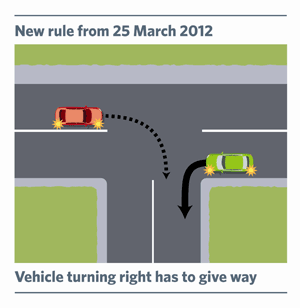
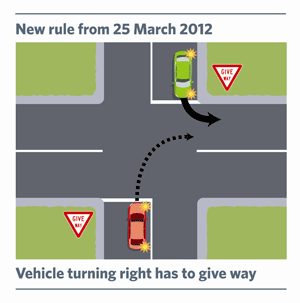 c) Both vehicles facing stop signs
c) Both vehicles facing stop signs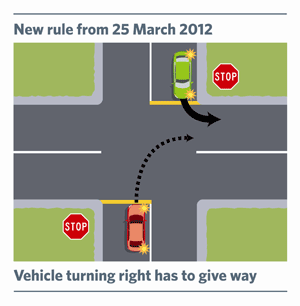
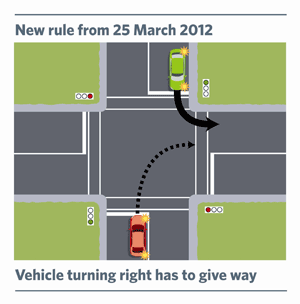
Uncontrolled means when there are no signs or signals to tell you what to do.
At an uncontrolled T-intersection, all traffic from a terminating road (bottom of the T) should give way to all traffic on a continuing road (top of the T). This brings it into line with T-intersections where there are stop or give way signs on the terminating road.
In the diagram below the RED car with the dotted arrow has to give way to the GREEN car with the solid arrow:
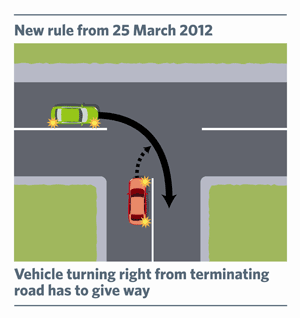
This rule change also applies at uncontrolled driveways, such as at a supermarket or hospital. The traffic exiting the driveway should give way to all traffic on the road.
All vehicles entering or exiting a driveway must continue to give way to pedestrians on a footpath, or cyclists and pedestrians on a cycle path or shared path. Drivers should not pull out to block the footpath in front of pedestrians and cyclists.
No. Traffic signs and signals are placed at intersections to show road users what they need to do and this will not change.
Here is a snapshot of the give way rules that now apply:
Road users should continue to obey all road signs and signals.
If you are turning, give way to all vehicles not turning. Note: If the road is marked with a centre line, you are deemed to be turning if you leave the path of the centre line. If you follow the path of the centre line, you are deemed to be not turning.
If you are turning right, give way to all vehicles coming towards you including those turning left. Note: This applies if both vehicles are facing no signs or signals or the same signs or signals. NEW RULE
At a T-intersection or driveway, traffic on a terminating road (bottom of the T) must give way to all traffic on a continuing road (top of the T). NEW RULE
If all other give way rules (or signs or signals) do not determine who gives way, give way to vehicles coming from your right. (An example of this is at cross roads controlled by traffic signals when the signals have failed and all approaches have a flashing yellow light.)
(Note: This is not a comprehensive list of road rules. Additional rules and traffic scenarios can be found in the Road code.)
No. You should continue to give way to all vehicles that will cross your path from your right as you enter a roundabout.